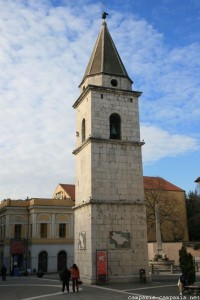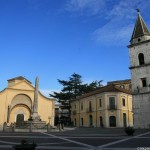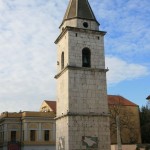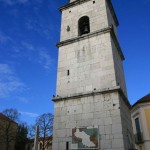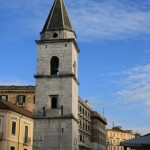This ensemble is notably constituted by the Saint-Sophia church, the campanile and the monastery (including the cloister).
The Saint Sophia Monastery
The current monastery, attached to the church, was built between 1142 and 1176 by Giovanni IV. There are fragments of the previous monument built in the eighth century, destroyed by an earthquake in 986.
Its most notable element is the cloister, of a Campanian Romanesque genre, with Arab influence. The openings of the cloister are decorated by 47 columns of granite, limestone and alabaster. They are all different, with small capitals representing foliage, allegories, animals or human figures.
From the eighth century, under Arigis II and his wife Adalberge who protected the studies of Paul Deacon, the monastery had an intense intellectual activity, in terms of doctrinal and humanistic research, which continued in the following centuries. By the year one thousand he had more than thirty intellectuals.
Moreover, the Scriptorium of Saint Sophia has developed a famous writing, called “lettera Beneventana” derived from the Lombards characters and used in the codes and documents in a large part of the south of Italy.
The old monastery now houses the Sannio Museum (also with the fortress of rectors) which has an archaeological collection (including many remains of the temple of Isis, as one of the two obelisks), weapons, prints , coins and an art gallery with paintings from the sixteenth to the eighteenth century.
The bell tower
The first bell tower was built by Gregory, abbot of Saint Sophia from 1038 to 1056, under the principality of Longobard Pandulf III, as indicated by a plaque in the south wall of the current. It collapsed in 1688.
The new bell tower was built in 1703 in another place.
The fountain
The Chiaramonte Fountain was built in 1806 under Talleyrand, then Prince of Benevento, who undertook to restore the great monuments of the city.
It consists of a circular basin where at its center stands an obelisk, supported by four lions, whose mouth the water flows.
The obelisk was crowned by a bronze globe with the imperial eagle, emblem of France.
One face bore the following inscription:
Carolo Maurizio / Optimo Principi / Pro publico curato bono Cives Beneventani / D.A. MDCCCIX
After 1815 and the restoration, the inscription was scratched, for a news in reference to Pope Pius VII. The imperial eagle was replaced by the triple crown of the popes, and later by the coat of arms of Italy.
- Santa Sofia, piazza Matteoti
- Le campanile sur la Place Santa Sofia
Learn more :


